-
past events
End-of-year Bookshop Sale Dec 13, 2025 - Dec 20, 2025
Eve Aboulkheir Lampo Performance Series Dec 06, 2025 Performance
Leila Bordreuil and Lee Ranaldo Lampo Performance Series Nov 08, 2025
Roc Jiménez de Cisneros Lampo Performance Series Oct 11, 2025
Concepción Huerta Lampo Performance Series Sep 27, 2025 Performance
Madlener House
4 West Burton Place
Chicago, Illinois 60610
Telephone: 312.787.4071
info@grahamfoundation.org
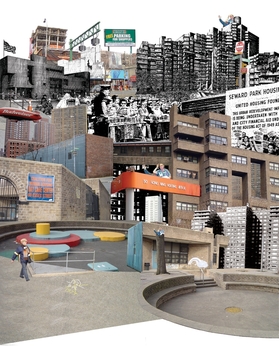
Buildings sit at the center of the global financial crisis. By way of a post-apocalyptic settlement in Montréal, a public learning center about finance and architecture in New York City, and a plan for the riverfront of Newark, New Jersey, Damon Rich's presentation will explore how tools of architecture might shift catastrophe to revitalize relationships between people and their living environments.
Damon Rich is a designer and artist who uses video, sculpture, graphics, and photography to investigate the political economy of the built environment. His work has been exhibited internationally at venues including the 2008 Venice Biennale, Storefront for Art and Architecture and SculptureCenter (New York City), the Canadian Centre for Architecture (Montréal), and Netherlands Architecture Institute (Rotterdam). In 1997, he founded the Center for Urban Pedagogy (CUP), a New York City nonprofit organization that uses the power of design and art to improve the quality of public participation in urban planning and community design, where he was the Creative Director for 10 years. His solo exhibition Red Lines Housing Crisis Learning Center, supported by a grant from the Graham Foundation, was on view at the Queens Museum of Art May 31-September 27, 2009.
Another CUP Development
http://www.damon.anothercupdevelopment.org
For more information on the exhibition, Actions: What You Can Do With the City, click here.
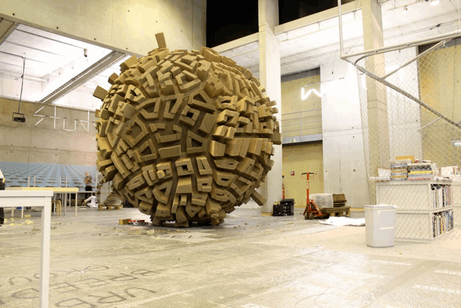
The Kaisersrot “Stadtigel” at the NAI in Rotterdam, 2009.
Just recently Alex Lehnerer published the book Grand Urban Rules with 010 Publishers, Rotterdam. Grand Urban Rules is a tribute to the city’s will to form, manifest in its vast number of steering regimes. The book contains a total of 115 significant ingredients for the Grand Projet of our contemporary metropolis. Not always positive but always powerful, these rules are the inverted, abstracted and extracted image of a city’s actual situation. Setting standards is first and foremost a cultural act. You can read cities by their rules! Rules link the physical with the social city, connecting quality with quantity and latent characteristics to manifest ones. Thereby and almost unnoticed, they have become design instruments. In fact, regarding rules as tools offers a valuable (urban) design attitude – departing from an approach that wants to control everything, and moving towards a non–fatalistic form of control between freedom and coercion.
Alex will discuss the content of the book and show its relevance for designers by relating it to other (urban design) projects of his. A limited amount of books will be available for sale.
Alex Lehnerer is an architect and urban designer, received his PhD from the ETH in Zurich where he was also a lecturer before moving to the US. With his studio he is currently based in Chicago where he holds a position as Asst. Professor at the University of Illinois, School of Architecture. He is partner of the urban research practice Kaisersrot in Zurich (CH) and ALSO-Architekten.
http://www.010.nl/catalogue/book.php?id=666
http://www.alexlehnerer.com
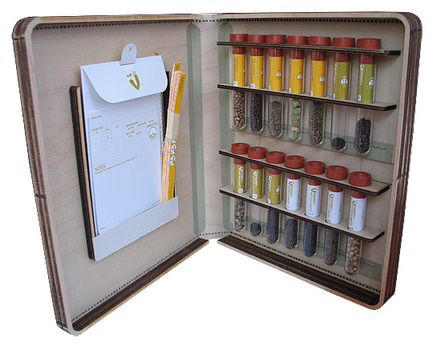
Victory Garden Seed Library
Amy Franceschini is a pollinator who creates formats for exchange and production that question and challenge the social, cultural and environmental systems that surround her. An overarching theme in her work is a perceived conflict between humans and nature. Her projects reveal the ways that local politics are affected by globalization. In 1995, Amy founded Futurefarmers, an international collective of artists. In 2004, Amy co-founded Free Soil, an international collective of artists, activists, researchers, and gardeners who work together to propose alternatives to the social, political and environmental organization of space. Free Soil has exhibited internationally and received funding from the Danish Arts Council, and Zero One, San Jose to create temporary public art projects. Amy’s solo and collaborative work have been exhibited internationally at ZKM, Whitney Museum, the New York Museum of Modern Art and Yerba Buena Center for the Arts, San Francisco. She received her BFA from San Francisco State University and her MFA from Stanford University. Amy is a professor of Art + Architecture at the University of San Francisco and a visiting artist at California College of the Arts Fine Arts Graduate program. Amy was awarded a grant from the Graham Foundation in 2008 for her project Victory Gardens 2007+.
Free Soil
http://www.free-soil.org
Atlas Magazine
http://www.atlasmagazine.com
For more information on the exhibition, Actions: What You Can Do With the City, click here.
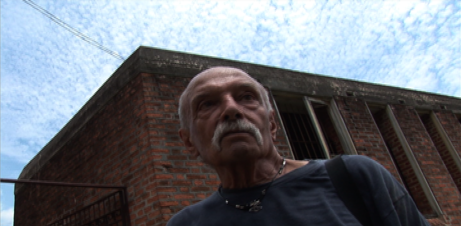
Talk: 5:30pm
Opening Reception: 6pm - 8pm
Artist Felipe Dulzaides and architect Roberto Gottardi will talk about the exhibition, Utopía Posible, and the School of Dramatic Arts. Please join us at a reception after the talk for the opening of the show.
Roberto Gottardi (Venice, 1927) is an architect and teacher living and working in Havana, Cuba. He studied at the Istituto Superiore d'Archittetura in Venice where he was a pupil of Carlo Scarpa, Franco Albini and Luigi Piccinato. Gottardi moved to Cuba in 1961 and promptly began work on his design for the School of Dramatic Arts. He has practiced and taught architecture and stage design there since.
Felipe Dulzaides (Cuba, 1965) is a visual artist whose work spans photography, installation, performance, video, and public art. Dulzaides' work has been exhibited at the San Francisco Museum of Modern Art, Kunstraum Kreuzberg/Bethanien (Berlin), Redcat (Los Angeles), and Yerba Buena Center for the Arts (San Francisco), among other venues. He is the recipient of prestigious awards including, the Cintas Fellowship 2001, the Creative Work Fund 2004 - 2005 and the 2010 Rome Prize. Dulzaides studied drama at the Instituto Superior de Arte and holds a Master of Fine Arts in New Genres from San Francisco Art Institute.
Utopía Posible was selected by Okwui Enwezor for the 7th Gwangju Biennale (2008) and featured in the 10th Havana Biennial (2009). The Graham Foundation presentation is the first in the United States, and features new work.
Space for the talk is limited, to make reservations email: rsvp@grahamfoundation.org or call 312.787.4071.
For more information on the exhibition, Utopía Posible, click here.
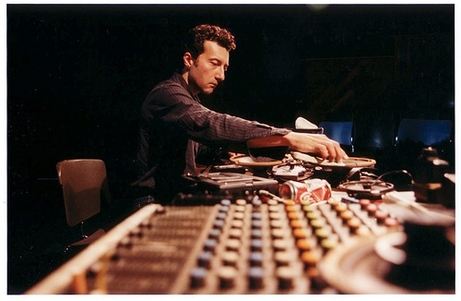
Reservations for this event are full.
Lionel Marchetti will present a two-hour musique concrète performance, an “interpretation with spatialization,” layering nature recordings, spoken text, pop songs and ethnic music through eight loudspeakers distributed around the Madlener House ballroom. Once on site, Marchetti will study the acoustics of the space and select appropriate works from his 20-year body of work.
The evening, brought to you by Lampo and the Graham Foundation, will be divided into two parts, each with its own direction and theme—perhaps “the natural world” or “human psychology,” or “shamanism,” a favorite of Marchetti’s, who sees parallels between the medicine man and composer, both as someone who transports you into another world.
Lionel Marchetti (b. 1967, Marseille, France) is an electroacoustic improviser and musique concrète composer. Initially self-taught, Marchetti studied with Xavier Garcia in Grenoble. A scholar, he later worked at the CFMI (Lyon) and INA-GRM studios (Paris), and published a book on composer Michel Chion.
In the mid-1990s Marchetti was one of a handful of artists who took electroacoustic music out of the academic studio and into the realm of free improv, using a live set-up with microphones, small speakers, tape recorders and radio. As an improviser he performs in his long-standing duo with Jérôme Noetinger, in the audio-visual project Le Cube, with influential collective Archipel, and with dancer Yôko Higashi. In his studio work he incorporates sound collage and electroacoustic composition, although the level of poetry and refusal of genre boundaries in his music puts him closer to Kristoff K. Roll and Luc Ferrari than Pierre Henry or Bernard Parmegiani. Lionel Marchetti made his U.S. debut at Lampo in June 2002, in a duo performance with Jérôme Noetinger.
Presented in partnership with Lampo.
Founded in 1997, Lampo is a non-profit organization for experimental music, sound art and intermedia projects. For information and to add your name to the Lampo list, contact info@lampo.org or visit www.lampo.org.

RESERVATIONS FOR THIS EVENT ARE FULL.
Graham Foundation grantees and authors Igor Marjanovic and Katerina Rüedi Ray will discuss their recently published book, Marina City: Bertrand Goldberg’s Urban Vision.
Chicago has many iconic buildings, but perhaps none as instantly recognizable as Bertrand Goldberg’s Marina City. Occupying an entire city block—number 1 of the original town of Chicago—the mixed-use riverside complex consists of two cylindrical sixty-five-story residential towers, a saddle-shaped auditorium, a midrise office building, and a rectangular podium comprising an open plaza with a variety of services. Each tower contains more than four hundred apartments and a continuous, upward-spiraling ramp of parking spaces. Built between 1960 and 1967 at a time when Chicagoans were fleeing to the suburbs, the hugely ambitious project was architect Goldberg’s collaborative attempt at urban revitalization—as he called it, “a city within a city.”
Igor Marjanovic and Katerina Rüedi Ray here present the first history of this architectural landmark. Featuring newly available archival texts, photographs, and drawings, this unique building’s biography explores not only its architectural achievements, but also the ingenious marketing campaign and complex network of political partnerships necessary to realize Goldberg’s urban vision. As the architect’s beautifully designed brochures detailed, Marina City offered residents a self-contained world that included a theater, restaurant, bowling alley, health club, ice-skating rink, grocery store, a bank, and much more. It is no wonder that before it was finished 2,500 applications had been submitted to rent 896 apartments. From financing to the structural engineering, this one-of-a-kind volume fills in missing chapters of modern architecture, urban politics, and labor history.
Igor Marjanovic is assistant professor of architecture at Washington University in St. Louis. Katerina Rüedi Ray is director and professor of the School of Art at Bowling Green State University. Marina City: Bertrand Goldberg's Urban Vision was supported by a grant from the Graham Foundation. Books will be available for purchase after the talk.
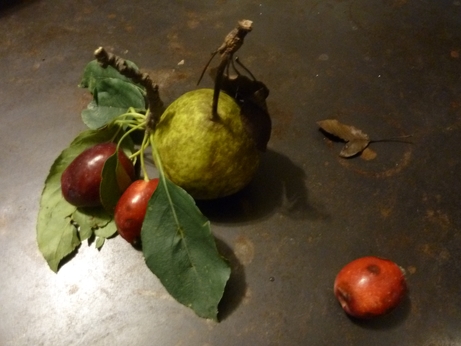
On Tuesday, October 5, 2010, Nance Klehm will lead a small group on a two hour Urbanforage of Chicago’s Gold Coast. On this informal guided walk through the spontaneous and cultivated vegetation of the urbanscape, participants will learn to identify plants, hear their botanical histories and stories of their use by animals and humans, and share antidotes of specific experiences with these plants. The Urbanforage will begin in the garden of the Graham Foundation’s Madlener House, where participants are invited to sample an herbal beverage made by the artist.
Nance Klehm began leading Urbanforages in 2006 in suburbs and cities including; Chicago, Los Angeles, Montreal, Salt Lake City, Philadelphia, New York and Mexico City. She is an ecological systems designer, landscaper, horticultural consultant, permacultural grower, consultant, speaker, and teacher. She is respected internationally for her work on land politics and growing for fertility. She has lectured at the Museum of Contemporary Art, the Hammer Museum in Los Angeles, the University of Cincinnati, and the Canadian Centre for Architecture in Montreal. She has taught at the University of California, Los Angeles, Northwestern University in Evanston, Illinois, and Dartington College in the United Kingdom. She writes a regular column for Arthur magazine and was included in the books Radical Homemakers (by Shannon Hayes), Participatory Autonomy (edited by Rick Gribenas), and The Revolution Will Not Be Microwaved: Inside America’s Underground Food Movements (by Sandor Katz).
Nance Klehm’s work was featured in the exhibition, Actions: What You Can Do With the City, which was on view at the Graham Foundation October 16, 2009 – March 13, 2010. http://cca-actions.org/ This event is presented in conjunction with Chicago Artist’s Month.
Chicago Artists Month
http://www.chicagoartistsresource.org/visual-arts/node/28865
Spontaneous Vegetation
http://spontaneousvegetation.net/
Actions: What You Can Do With the City
http://cca-actions.org/
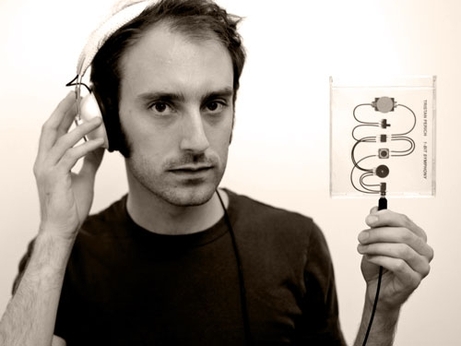
On Saturday, October 16, Tristan Perich will present his 1-Bit Symphony, a five-movement work that uses binary electrical pulses to create sound and light.
Trained in mathematics and piano, Perich (b. 1982, New York) works in acoustic and electronic music. Best known for his constructions that explore the physicality of sound and the polyphonic potential of 1-bit audio, his “1-Bit Music” (2004-05) and “1-Bit Symphony” (2010) celebrate the virtuosity of electricity. Neither release is a traditional recording. Instead, each is a music-generating circuit, housed in a CD jewel case with a headphone jack. Perich also has composed several works for musicians with 1-bit music accompaniment, and is in the music group the Loud Objects (with Kunal Gupta and Katie Shima), which performs by soldering its own noise-making circuits live in front of the audience.
As a visual artist, his projects include “Machine Drawings,” pen-on-paper drawings executed by machine, and 1-bit video, low-resolution black and white images synthesized by microchips and displayed on cathode ray televisions.
His work has been recognized by Prix Ars Electronica, commissioned by Rhizome, Bang on a Can and turbulence.org, and performed and exhibited throughout the U.S. and abroad. Perich graduated from Columbia University, and more recently received a master’s degree in art, music and electronics at the Interactive Telecommunications Program at Tisch School of the Arts, New York University.
http://www.tristanperich.com/
Perich's 1-Bit Symphony was reviewed by the New York Times in August. Read the article here.
Presented in partnership with Lampo.
Founded in 1997, Lampo is a non-profit organization for experimental music, sound art and intermedia projects. For information and to add your name to the Lampo list, contact info@lampo.org or visit www.lampo.org.
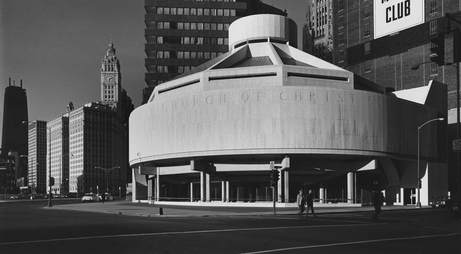
Seventeenth Church of Christ, Scientist, Chicago; designed by Harry Weese and Associates, 1968. Photo by Orlando Cabanban. Printed with permission from W.W. Norton & Company.
55 East Wacker Drive
Chicago, IL 60601
Please note location.
On Tuesday, October 26, the Graham Foundation for Advanced Studies in the Fine Arts will host a free lecture celebrating the release of The Architecture of Harry Weese, a new book by Robert Bruegmann and Kathleen Murphy Skolnik. The public is invited to experience the architecture of Harry Weese firsthand by joining Bruegmann for a lecture on the architect’s legacy in one of his most important buildings, the Church of Christ, Scientist, Chicago. Built in 1968, the church is a consummate example of the architect’s pioneering style and his significant contributions to Chicago’s architectural history. The lecture will be followed by a book signing.
During a career that spanned half a century from the 1930s to the 1980s, Harry Weese (1915 - 1998) produced a large number of significant designs ranging from small but highly inventive houses to large urban scale commissions like the Washington, D.C. Metro system. As the first monograph solely devoted to Weese’s work, the book revives the reputation of a visionary architect. This book takes its place within a fast-growing revival of interest in the work of Weese and a number of his friends and contemporaries with shared assumptions and sensibilities, notably Eero Saarinen, Edward Larrabee Barnes, I. M. Pei, Ralph Rapson, and Paul Rudolph. As important as Weese’s buildings were, though, they were only one part of what almost all his contemporaries recognized as his seemingly inexhaustible creativity. Because Weese believed that design was essentially problem-solving, he was willing to apply his skills to everything from a piece of furniture to an entire city. The city on which he lavished the most attention was his own city, Chicago, where he seemed to be everywhere at once, praising, criticizing, cheerleading, and pouring out ideas for creating a humane and livable place for citizens of all walks of life. Although influenced to some degree by the rational, and often austere, work of European modernists like Mies van der Rohe, in most of his own oeuvre Weese instead followed the example of Nordic architects like Gunnar Asplund and Alvar Aalto in favoring natural materials, human scale, and comfort; his work was characterized by a deep respect for older buildings and existing urban patterns and a fondness for unexpected, often idiosyncratic design decisions.
The Architecture of Harry Weese was supported by a 2004 grant from the Graham Foundation. It is published by W.W. Norton & Company. Books will be available for purchase the day of the event.
ABOUT THE AUTHORS
Robert Bruegmann, an historian of architecture, landscape, and the built environment, is University Distinguished Professor of Art History, Architecture and Urban Planning at the University of Illinois at Chicago. His most recent book is Sprawl: A Compact History (University of Chicago Press).
Kathleen Murphy Skolnik holds an MA in art history with a concentration in architectural history from the University of Illinois at Chicago and teaches art history at Roosevelt University in Chicago.
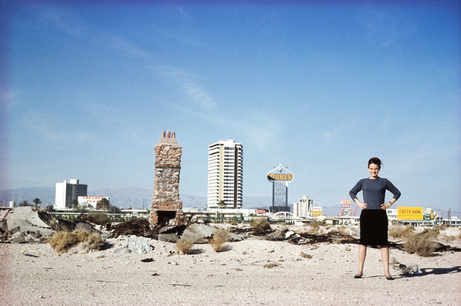
Robert Venturi, The Strip seen from the desert with Denise Scott Brown in the foreground, 1966 © Venturi, Scott Brown and Associates, Inc., Philadelphia.
Join the Graham Foundation for the opening of Las Vegas Studio: Images from the Archives of Robert Venturi and Denise Scott Brown. This event is free and open to the public.
In 1968, American architects Robert Venturi, Denise Scott Brown, and Steven Izenour, with students from Yale University, embarked on a groundbreaking investigation of the Las Vegas Strip. Their fresh way of looking at the city: the influence of popular culture, advertising, film and the experience of the built environment from a moving automobile extended the categories of the ordinary, the ugly, and the social into architecture. Their use of photography and film as a research methodology became as revolutionary as their findings, which were published in the legendary 1972 book, Learning from Las Vegas. Offering great insight into the creation of this groundbreaking publication, the exhibition, Las Vegas Studio: Images from the Archives of Robert Venturi and Denise Scott Brown, curated by Hilar Stadler and Martino Stierli in collaboration with artist Peter Fischli, presents original research materials from the archives of Venturi, Scott Brown and Associates, Inc.
Las Vegas Studio: Images From the Archives of Robert Venturi and Denise Scott Brown is organized by The Museum im Bellpark, Kriens, Switzerland.
For more information on the exhibition, Las Vegas Studio: Images from the Archives of Robert Venturi and Denise Scott Brown, click here.
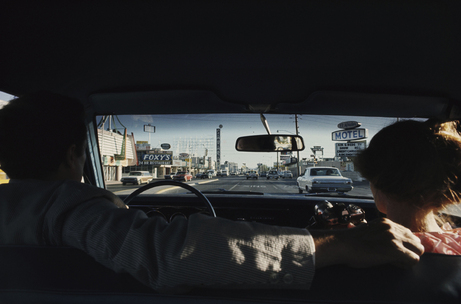
Robert Venturi and Denise Scott Brown in Las Vegas, 1966 © Venturi, Scott Brown and Associates, Inc., Philadelphia
Almost immediately upon its publication in 1972, Learning from Las Vegas was hailed as a landmark in the theory of modern architecture and urbanism. For its authors Robert Venturi, Denise Scott Brown, and Steven Izenour, traditional visual techniques were no longer adequate for the analysis and representation of the city. For this reason, they made extensive use of new media such as photography and film. Photography and film served them for both the analysis and the representation of the city. Despite its prominence in architectural debates, there have been only partial attempts to locate this seminal urbanistic study within the discourse on the image of the city prevalent in the 1950s and 1960s. Exhibition co-curator Martino Stierli presents original film footage and photographs from the 1968 Learning from Las Vegas research, some of which has only been made accessible for the first time to the public in the exhibition, Las Vegas Studio: Images from the Archives of Robert Venturi and Denise Scott Brown.
Martino Stierli is an art historian focusing on modern art and architecture, born in 1974 in Zug, Switzerland, Stierli studied at the University of Zurich and holds a Ph.D. from ETH Zurich. He is currently a postdoctoral fellow at the NCCR "Iconic Criticism" (eikones) at the University of Basel working on a project on collage in architecture.
For more information on the exhibition, Las Vegas Studio: Images from the Archives of Robert Venturi and Denise Scott Brown, click here.
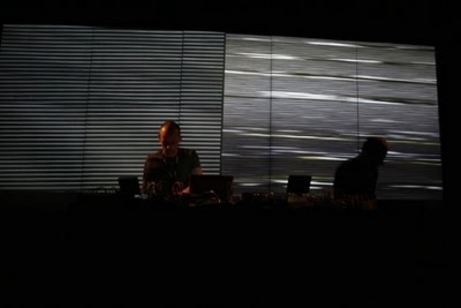
On Saturday, November 6, Dutch artists Bas van Koolwijk and Gert-Jan Prins bring you Synchronator, a stunning audiovisual project that adds video sync pulses and color coding signals to sound. The collaborative work is a continuation on medium specific experiments between image and sound from the early years of video art.
Bas van Koolwijk (b. 1966, Nijmegen, The Netherlands) works with video errors and digital code to create sound and image interactions. He uses self-made software and hardware applications in live performances, installations and video compositions. He has appeared at media art festivals worldwide, including Impakt in the Netherlands, Mutek in Canada, Netmage in Italy, Avanto in Finland, European Media Art Festival in Germany and Courtisane in Belgium. From 2003 to 2006 Van Koolwijk was part of Umatic, a small group of Dutch artists working in the different fields of net-, video- and sound art. He lives in Utrecht.
Gert-Jan Prins (b. 1961, IJmuiden, The Netherlands) is a self-taught artist who focuses on the sonic and musical qualities of electronic noise. In his work, Prins makes connections with modern electronic club culture, occupying a radical position with his investigation of electronic sound and its relationship to the visual. Current projects include M.I.M.E.O. (the 12-piece Movement in Music Electronic Orchestra) and a duo with Tomas Korber. Prins first appeared at Lampo in April 2004, when he performed an extended version of “Risk,” (Mego) his solo project for electronics, customized transmitters, television and AM/FM radio.
http://www.synchronator.com/
Presented in partnership with Lampo.
Founded in 1997, Lampo is a non-profit organization for experimental music, sound art and intermedia projects. For information and to add your name to the Lampo list, contact info@lampo.org or visit www.lampo.org.
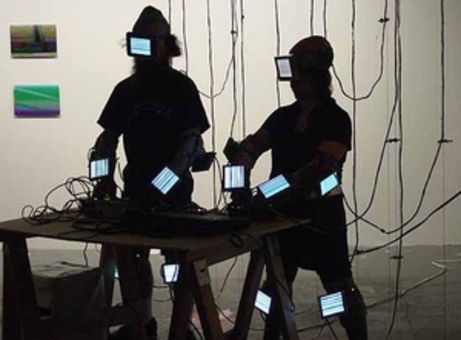
On Saturday, December 4, Tali Hinkis and Kyle Lapidus of LoVid will perform with their Sync Armonica, a 9 ft. sculptural, analog, handmade A/V synthesizer.
LoVid's performances use realtime audiovisuals that are immersive, visceral and intensely colorful, patterned and rhythmic. Works combine handmade and machine produced craft, DIY electro-engineering, textile, video and noise.
LoVid is the art duo of Tali Hinkis (b. 1974, Jerusalem) and Kyle Lapidus (b. 1975, New York). Working together since 2001, LoVid’s interdisciplinary works explore social, personal and corporal experiences in the networked era. The duo’s events are playful yet aggressive, with realtime audiovisuals that are immersive, visceral and intensely colorful, patterned and rhythmic. LoVid has performed and exhibited internationally in venues such as: Real Art Ways, Urbis (Manchester), MoMA, PS1, The Kitchen, The Jewish Museum, The Neuberger Museum, The New Museum of Contemporary Art and Institute of Contemporary Art (London). LoVid has been artist in residence at Smack Mellon, Cue Art Foundation, Eyebeam, Harvestworks, free103point9, and has received grants, awards, and fellowships from NYFA, LMCC, Experimental TV Center, NYSCA, Foundation for Contemporary Arts, turbulence.org, Puffin Foundation, and Greenwall Foundation.
http://www.lovid.org/
Presented in partnership with Lampo.
Founded in 1997, Lampo is a non-profit organization for experimental music, sound art and intermedia projects. For information and to add your name to the Lampo list, contact info@lampo.org or visit www.lampo.org.
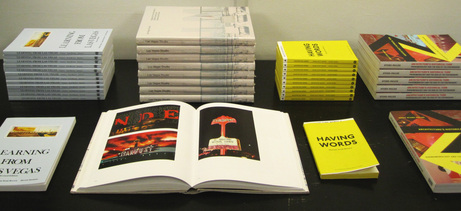
Toast the holiday season and the kick off of the Graham Foundation's mini book store in the library. Please join us from 5PM to 8PM to enjoy the Graham Foundation's current exhibition, Las Vegas Studio: Images from the Archives of Robert Venturi and Denise Scott Brown, and shop its new book store for holiday gifts. All titles will be 20% off including,
...the exhibition catalogue,
Las Vegas Studio
EDITED BY HILAR STADLER AND MARTINO STIERLI
...a new collection of essays by Denise Scott Brown,
AA Words 4: Having Words
DENISE SCOTT BROWN
...classics,
Learning From Las Vegas
ROBERT VENTURI, DENISE SCOTT BROWN & STEVEN IZENOUR
Complexity and Contradiction in Architecture
ROBERT VENTURI
...recent grantee publications,
Log 20: Curating Architecture
ANYONE CORPORATION
Katarina Grosse: Atoms Inside Balloons
ESSAYS BY DAVID HILBERT AND NANA LAST
Architecture's Historical Turn, Phenomenology and the Rise of the Postmodern
JORGE OTERO-PAILOS
& more!
Book sale proceeds benefit the Graham Foundation's public programs.
Unless otherwise noted,
all events take place at:
Madlener House4 West Burton Place, Chicago
GALLERY AND BOOKSHOP HOURS
2025 Chicago Architecture Biennial
SHIFT: Architecture in Times of Radical Change
Sep 19, 2025–Feb 28, 2026
Wed–Sat, 12–5 p.m.
HOLIDAY HOURS: the galleries and bookshop are closed Dec 24, 2025 through Jan 3, 2026
Regular hours resume on Jan 7, 2026
CONTACT
312.787.4071
info@grahamfoundation.org
Accessibility
Events are held in the ballroom on the third floor which is only accessible by stairs.The first floor of the Madlener House is accessible via an outdoor lift. Please call 312.787.4071 to make arrangements.
Copyright © 2008–2026 Graham Foundation. All rights reserved.